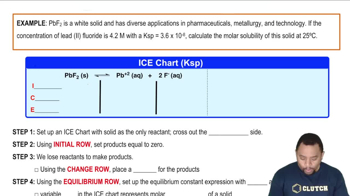Two compounds with general formulas AX and AX2 have Ksp = 1.5⨉10-5. Which of the two compounds has the higher molar solubility?
Ch.18 - Aqueous Ionic Equilibrium
Chapter 18, Problem 101a
Calculate the molar solubility of barium fluoride in each liquid or solution. a. pure water
 Verified step by step guidance
Verified step by step guidance1
Write the dissolution equation for barium fluoride: \( \text{BaF}_2 (s) \rightleftharpoons \text{Ba}^{2+} (aq) + 2\text{F}^- (aq) \).
Write the expression for the solubility product constant \( K_{sp} \) for barium fluoride: \( K_{sp} = [\text{Ba}^{2+}][\text{F}^-]^2 \).
Let the molar solubility of \( \text{BaF}_2 \) be \( s \). Then, at equilibrium, \([\text{Ba}^{2+}] = s\) and \([\text{F}^-] = 2s\).
Substitute these expressions into the \( K_{sp} \) expression: \( K_{sp} = (s)(2s)^2 = 4s^3 \).
Solve for \( s \) by setting \( 4s^3 = K_{sp} \) and taking the cube root of both sides to find the molar solubility of \( \text{BaF}_2 \) in pure water.

Verified video answer for a similar problem:
This video solution was recommended by our tutors as helpful for the problem above.
Video duration:
7mWas this helpful?
Key Concepts
Here are the essential concepts you must grasp in order to answer the question correctly.
Molar Solubility
Molar solubility refers to the maximum amount of a solute that can dissolve in a given volume of solvent at equilibrium, expressed in moles per liter (mol/L). It is a crucial concept in understanding how substances interact in solution and is influenced by factors such as temperature and the presence of other ions.
Recommended video:
Guided course

Molar Solubility Example
Solubility Product Constant (Ksp)
The solubility product constant (Ksp) is an equilibrium constant that applies to the dissolution of sparingly soluble ionic compounds. It quantifies the extent to which a compound can dissolve in water, represented by the product of the molar concentrations of its ions, each raised to the power of their coefficients in the balanced dissolution equation.
Recommended video:
Guided course

Solubility Product Constant
Dissociation of Ionic Compounds
Dissociation of ionic compounds occurs when an ionic solid separates into its constituent ions in solution. For barium fluoride (BaF2), this process can be represented by the equation BaF2(s) ⇌ Ba²⁺(aq) + 2F⁻(aq). Understanding this dissociation is essential for calculating molar solubility, as it directly relates to the concentrations of the ions in solution.
Recommended video:
Guided course

Ionic Compounds Naming
Related Practice
Textbook Question
Textbook Question
Consider the compounds with the generic formulas listed and their corresponding molar solubilities in pure water. Which compound has the smallest value of Ksp? a. AX; molar solubility = 1.35⨉10-4 M b. AX2; molar solubility = 2.25⨉10-4 M c. A2X; molar solubility = 1.75⨉10-4 M
Textbook Question
The solubility of copper(I) chloride is 3.91 mg per 100.0 mL of solution. Calculate Ksp for CuCl.
Textbook Question
Calculate the molar solubility of barium fluoride in each liquid or solution. b. 0.10 M Ba(NO3)2
Textbook Question
Calculate the molar solubility of barium fluoride in each liquid or solution. c. 0.15 M NaF
Textbook Question
Calculate the molar solubility of MX (Ksp = 1.27⨉10-36) in each liquid or solution. b. 0.25 M MCl2
